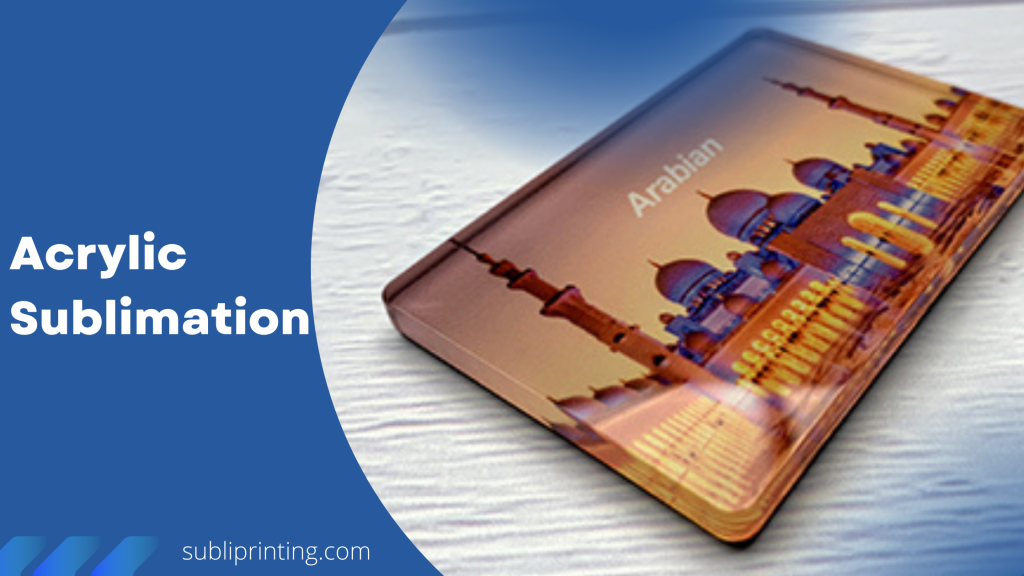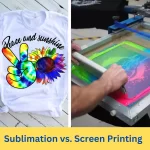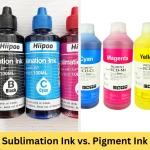Have you ever wondered if you can sublimate on acrylic? Well, yes! The possibilities of acrylic sublimation are endless. You can sublimate on acrylic keychains, ornaments, acrylic cups, tumblers, and many other acrylic blanks.
I’ve always been a fan of acrylic art, but I’ve never been able to afford original pieces. That’s why I was so excited when I learned about sublimation on acrylic. With its exceptional clarity, durability, and smooth surface, acrylic offers a brilliant backdrop for transferring stunning designs.
Throughout this article, I’ll guide you through every step of the sublimation process on acrylic, from prepping the blanks to achieving perfect results.
Contents
- What is Acrylic?
- Acrylic Sublimation
- How to Sublimate on Acrylic: Step-by-Step Guide
- Step 1: Prepare Your Design File
- Step 2: Print Your Design on Sublimation Paper
- Step 3: Apply Protective Tape
- Step 4: Position the Printed Paper onto the Acrylic
- Step 5: Preheat the Heat Press
- Step 6: Place the Acrylic in the Heat Press
- Step 7: Press the Acrylic
- Step 8: Remove the Printed Paper
- Step 9: Clean the Acrylic Surface
- How to Sublimate on Curved Acrylic Items?
- Exploring Different Acrylic Blanks
- Considerations for Successful Acrylic Sublimation
- Wrapping Up
- Frequently Asked Questions
What is Acrylic?

Acrylic is a hard thermoplastic made from a methyl methacrylate polymer. It is a type of transparent solid plastic that is lightweight, durable, and can be easily molded when heat is applied.
It is often used as a substitute for glass because it is more shatter-resistant and less prone to scratching.
Types of Acrylic That You Can Sublimate
There are different types of acrylic that you can sublimate, each with its own distinct qualities.
Clear acrylic, as the name suggests, offers a transparent finish that allows your designs to shine through with exceptional clarity. This type of acrylic is perfect for showcasing vibrant colors and intricate details.
Frosted or textured acrylic, on the other hand, adds a subtle and elegant touch to your sublimated creations. This type of acrylic can create unique effects, such as a woven or brushed appearance, enhancing the overall look of your finished products.
Acrylic Sublimation
Sublimation is the perfect solution if you are looking to add some personalization to your acrylic items. You can use the acrylic blanks to custom design a variety of different items, such as acrylic keychains, cups, and acrylic ornaments.
When it comes to sublimating on acrylic, having the right materials and supplies is crucial to achieve professional and long-lasting results.
The process of sublimating on acrylic is very similar to the process of sublimating on other materials (like polyester).
Supplies for Acrylic Sublimation
You will need the following items to sublimate on acrylic;
- A sublimation printer
- Sublimation paper
- Sublimation ink
- Acrylic blank
- Heat press machine
- Heat resistant tape
- Butcher paper
- Lint roller
- Scissor
- Heat gun or hair dryer
- Design software
Most Popular Acrylic Sublimation Keychain Blanks
Prepping Sublimation Blanks
Before you can sublimate on acrylic, you need to prepare the blank. This involves removing the protective coating from the surface and cleaning the acrylic.
Removing and Cleaning the Protective Coating
The protective coating on acrylic prevents the sublimation ink from transferring to the surface. Any dirt, dust, or fingerprints on the surface can prevent the sublimation ink from transferring properly.
To remove the coating, you can use a heat gun or a hair dryer.
Step 1: Heat the acrylic blank with a heat gun or hair dryer on a high setting.
Step 2: The protective coating will start to loosen up and make bubbles, pull to peel it away.
Step 3: Wipe the acrylic surface with a damp cloth.
Step 4: Use a lint roller to remove any remaining bits of coating.
How to Sublimate on Acrylic: Step-by-Step Guide
The wait is over – now, I’m going to share step by step guide as per my personal experience to achieve stunning acrylic sublimation results.
Step 1: Prepare Your Design File
Begin by preparing your design using sublimation software such as Adobe Photoshop, CorelDRAW, or Inkscape. Make sure to set the dimensions of your design file to match the size of the acrylic blank you’ll be working with.
Step 2: Print Your Design on Sublimation Paper
Once your design is ready, it’s time to print it onto sublimation paper using a sublimation printer and sublimation ink.
Note that sublimation ink is different from regular inkjet ink. Sublimation ink turns into a gas when heated, allowing it to bond with the acrylic surface.
Ensure that you use sublimation ink and sublimation paper designed for this purpose.
Optional step: cut out the extra paper with the help of a scissor for proper fitting.
Step 3: Apply Protective Tape
To prevent any unwanted transfer of ink and ensure clean edges, apply heat-resistant or protective tape around the edges of the printed sublimation paper.
This tape acts as a barrier and holds the paper securely in place during the heat transfer process.
Step 4: Position the Printed Paper onto the Acrylic
Take your clean and prepped acrylic blank (tumbler, cup, keychain, etc.) and carefully position the printed sublimation paper onto its surface.
Pay attention to aligning the edges and corners of the paper with the acrylic blank for accurate placement.
Step 5: Preheat the Heat Press
Preheating the heat press is crucial for achieving optimal sublimation results. Refer to the manufacturer’s instructions to set the appropriate temperature and time for sublimating on acrylic.
Allow the heat press to reach 380°F (193°C) temperature before proceeding.
Step 6: Place the Acrylic in the Heat Press
Once the heat press is preheated, open it and place the acrylic blank with the attached sublimation paper onto the heat press bed. Make sure that the sublimation paper is facing down onto the acrylic surface.
Step 7: Press the Acrylic
Close the heat press and apply even pressure and heat onto the acrylic blank. For brighter sublimation results on acrylic, set the heat press machine’s settings from 380°F to 400°F (193°C to 204°C) and a pressing time of about 60 seconds.
Step 8: Remove the Printed Paper
Once the pressing time is complete, carefully open the heat press and remove the acrylic blank. Be cautious as it will be hot, it is advised to use heat-resistant gloves.
Peel off the sublimation paper from the acrylic surface, revealing the beautifully transferred design. This moment is always exciting and satisfying, as you witness your design come to life on the acrylic surface.
Step 9: Clean the Acrylic Surface
After removing the paper, take a moment to inspect the acrylic surface for any residue or imperfections.
Use a soft, lint-free cloth and a mild cleaner specifically designed for acrylic surfaces to gently clean and polish the sublimated acrylic.
Note: some paper may stick on the acrylic – it is normal! Dip the acrylic item in the water for a couple of minutes to soften the paper, then rub and clean it. Enjoy your new acrylic sublimation!
Video Tutorial on Acrylic SublimtionHow to Sublimate on Curved Acrylic Items?
If you want to transfer an image onto a curved acrylic item such as mugs and ornaments, you will need to use a curved sublimation acrylic sheet, and a curved heat press. The process is very simple and you will need the following items:
- A curved sublimation acrylic sheet
- A curved heat press
- An image printed on sublimation paper
- A piece of cardboard
- Scissor
1. Print your image on the sublimation paper.
2. Cut the image to the size of the curved acrylic sheet.
3. Place the image face down on the curved sublimation acrylic item.
4. Place the cardboard on top of the image and heat press at 375 to 400 degrees for 45 seconds.
5. Remove the cardboard and let the image cool.
Video Tutorial on Acrylic Sublimation on Curved Items and Sheets
Exploring Different Acrylic Blanks
There’s a wide range of blanks available that can serve as fantastic canvases for your creativity. Drawing from my personal experience, let’s explore some popular options and the possibilities they offer:
Sublimation Acrylic Bookmarks
Acrylic bookmarks are not only functional but also offer a great opportunity for expressing your artistic flair. You can experiment with vibrant designs, inspirational quotes, or even personalized messages.
The transparency of acrylic adds a unique touch to the sublimated bookmarks, making them visually appealing and durable.
Sublimation on Regular Acrylic
While sublimating on clear acrylic is commonly practiced, it’s worth mentioning that you can also achieve impressive results on regular acrylic sheets. With proper surface preparation and sublimation techniques, you can create stunning wall art, signage, or decorative pieces.
Sublimation on Acrylic Nightlights
Acrylic nightlights offer a captivating way to light up your designs. The light passes through the sublimated acrylic, creating a beautiful and mesmerizing effect.
You can explore various themes, and patterns, or even customize nightlights with personal photos. The combination of sublimation and acrylic’s glassy properties brings your designs to life in a whole new light, quite literally!
Considerations for Successful Acrylic Sublimation
Having delved into the world of acrylic sublimation and gained valuable personal experience, I want to share some important considerations to ensure your sublimation attempts on acrylic are successful.
Can You Sublimate on Acrylic Fabric?
Yes, you can sublimate on acrylic fabric. However, the results may not be as good as sublimating on a solid piece of acrylic. This is because the fabric may not be as smooth, and the ink may not transfer as evenly.
Acrylic sublimation typically refers to sublimating on solid acrylic surfaces. While acrylic fabric is commonly used in textiles, it doesn’t possess the same sublimation properties as solid acrylic.
Understanding Acrylic Sublimation Temperature and Timing
The temperature and timing for sublimation on acrylic will vary depending on the type of acrylic you are using and the heat press you have. Generally, the recommended temperature for sublimating on acrylic typically ranges from 380°F to 400°F (193°C to 204°C).
Additionally, the pressing time usually falls within the range of 45 to 60 seconds. However, I have noticed vibrant results after applying pressure for 60 seconds.
What Happens When Acrylic Is Heated?
When acrylic is heated during the sublimation process, it undergoes a transformation. It becomes more flexible, allowing the sublimation ink to bond with the surface.
However, it’s crucial to handle heated acrylic with caution to avoid burns or damage. Always use protective gloves when handling hot acrylic blanks, and allow them to cool down before further handling or packaging.
Wrapping Up
So, the answer is clear: you can indeed sublimate on acrylic. Throughout this article, we’ve explored the process step-by-step, discussed the different types of acrylic suitable for sublimation, and highlighted the importance of quality materials and proper preparation.
The world of acrylic sublimation offers endless creative possibilities. You can custom design your belongings with beautiful prints or loved ones’ images such as keychains, cups, ornaments, and acrylic fabric.
If you are looking for a way to add some personalization to your acrylic items, then sublimation is the perfect solution. With a little bit of creativity, you can create some truly unique designs that will stand out from the crowd.
Frequently Asked Questions
Can you sublimate in a regular oven?
No, you cannot sublimate in a regular oven. You will need a heat press to properly transfer the image onto the acrylic blank.
Can acrylic be sublimated?
Yes, acrylic can be sublimated. The process is very simple and you can create a variety of different items using acrylic blanks.
What temperature does acrylic sublimate?
The recommended temperature for acrylic sublimation is 375 – 400 degrees. However, the time may vary depending on the type of heat press you are using and the thickness of the acrylic item.
Can you sublimate on acrylic cups?
Yes, you can sublimate on acrylic cups. You will need to use a curved sublimation acrylic sheet in order to do so.
Can you put acrylic in a heat press?
Yes, you can put acrylic in a heat press. You will need to use a piece of cardboard in order to protect the acrylic from the heat.
- 5 Best 13×19 Sublimation Printer for Wide Format Substrates - December 27, 2023
- Best 11×17 Sublimation Printer to Print Tabloid Size Paper - December 26, 2023
- Epson ET-8550 vs ET-15000: Best Wide-Format EcoTank Printer - December 25, 2023





![How to Sublimate on Wood? Pro Tips & Best Method [Tested] wood sublimation](https://subliprinting.com/wp-content/uploads/2022/04/wood-sublimation-150x150.png)
![Sublimation on Leather Products [Guide for Best Results] can you sublimate on leather](https://subliprinting.com/wp-content/uploads/2023/07/can-you-sublimate-on-leather-150x150.webp)


